In 2026, Protecht pricing has become a key question for GRC teams evaluating enterprise risk and compliance platforms.
Protecht has been known for its robust risk, incident, and controls management, but with custom quotes and no public plans, it’s hard to know what you’ll actually pay and assess its value for money.
In this guide, I’ll break down what’s known about Protecht’s pricing model, what drives costs, and whether it delivers enough value for modern, fast-moving organizations.
I’ll also compare it to a no-code GRC alternative with transparent pricing that's been built to launch faster, scale easier, and cost less.
Let’s dive in!
TL;DR
- Protecht is a configurable GRC platform built for large enterprises, but its custom pricing, longer setup, and steeper learning curve can make it harder to adopt quickly.
- Protecht's starting price has been reported to be somewhere around $45,000/year, according to insiders.
- SmartSuite offers a modern, no-code alternative with transparent pricing, ready-made GRC templates, and real-time reporting, helping teams get up and running fast.
- SmartSuite's pricing starts at $12 per user/month, with a Free Forever plan and a 14-day free trial with no credit card required.
Does Protecht offer a free plan or trial?
Protecht doesn’t make it easy to test-drive the platform before you buy.
There’s no public free plan and no instant self-serve trial: only a “Request a Demo” option on the website.
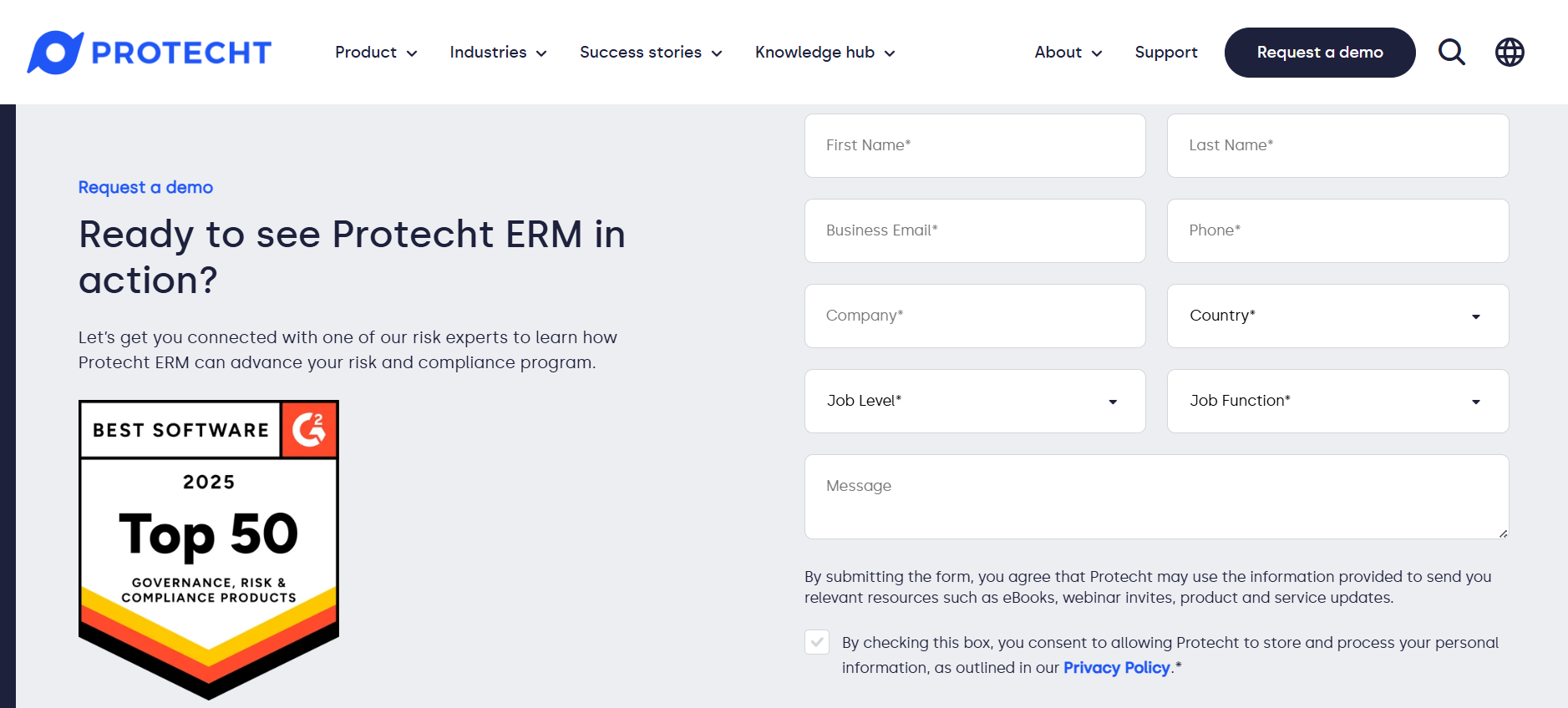
Source: Protecht.
That means you’ll need to go through the sales team to see the product in action.
Some third-party directories mention a “free trial,” but in practice, this usually refers to a guided proof-of-concept rather than hands-on access.
You can’t just sign up, explore the dashboard, and see how it fits your workflows the way you can with newer, more open GRC tools.
This model fits Protecht’s enterprise focus - it’s designed for organizations that expect a tailored deployment and have time for a formal evaluation process.
But if you’re part of a lean or fast-moving compliance team, this lack of self-serve access can slow things down and make it harder to compare options side by side.
In short, Protecht invites you to a demo, not a test drive, and for many buyers, that makes early evaluation a little less convenient.

Protecht pricing plans
Protecht doesn’t publish standard pricing tiers or package details publicly.
Instead, it follows a custom-quote model, where annual license fees are based on the number and type of active users.
Additional costs apply for premium modules such as Operational Resilience or pre-configured templates from the Protecht Marketplace.
This means pricing can vary widely depending on your organization’s size, user mix, and the specific governance, risk, and compliance modules you choose to deploy.
While Protecht highlights its scalability - claiming it’s fit for everyone from small teams to enterprises with thousands of users - its pricing structure reflects an enterprise-oriented approach.
Overall, the total cost will depend on how many licenses you purchase, the hosting setup, any implementation or training services, and whether you include optional modules.
Because of this tailored approach, Protecht’s pricing is best suited to larger organizations with formal procurement processes and clearly defined risk management frameworks.
Smaller teams looking for transparent, self-serve plans may find the custom-quote model slower and harder to budget for compared to some modern, more agile GRC platforms.
How much does Protecht actually cost?
When you dig into vendor and review-site data for Protecht in 2026, the picture becomes clearer, though still not entirely transparent:
- The vendor states licence pricing is based on the number and type of named active users, and that additional modules (for example, “pre-configured templates” or “Operational Resilience”) incur separate charges.

Source of image: Protecht.
Independent sources list a “starting price around USD 45,000/year” as a ballpark. For example, Capterra shows “Starting at $45,000.00 per year.”

So, if you’re budgeting for Protecht in 2026, expect to plan for five-figures annually - likely $45K+ PA as a baseline in many cases - plus potential extra costs for modules, onboarding, customisation and support.
For organizations without enterprise budgets, that means it may represent a heavier investment than newer GRC tools with transparent, flatter pricing.
Does Protecht provide good value for money?
When it comes to assessing whether Protecht delivers value for money in 2026, the answer is a yes for organizations with mature GRC needs, but there are some important trade-offs to keep in mind.
On the one hand, many users praise Protecht for its flexibility and configurability, and highlight that risk registers, dashboards and workflows can be tailored to the business.
It also offers a broad scope across governance, risk, compliance, incident, audit and resilience functions, which means fewer standalone tools and greater consolidation.
However, despite being an enterprise-focused platform, Protecht’s reporting features are somewhat limited, especially when compared to other industry software.

Moreover, some reviewers mention that usage beyond basic modules (e.g., custom dashboards) may involve additional cost or specialist skills.

Finally, some users find its UI to be rather clunky and prone to lagging, particularly when handling large data volumes.

So, if your organisation is managing multiple risk-domains, needs deep configurability, has experienced risk professionals and can invest in proper implementation and change management, then Protecht offers solid value, thanks to its scope, flexibility and positive user feedback.
However, if you’re a smaller team, new to GRC platforms, or need something you can deploy rapidly with minimal consulting overhead, the investment (both financial and time) may tip the value equation in favour of more streamlined alternatives.
Looking for a Protecht alternative?
If Protecht’s enterprise pricing, configuration demands, or limited trial access have you rethinking your next GRC investment, you’re not alone.
Many teams today want the same governance, risk, and compliance depth, just delivered faster, more transparently, and without the heavy lift of a traditional rollout.
That’s where SmartSuite stands out.

SmartSuite delivers the same enterprise-grade GRC capabilities Protecht is known for, but in a modern, no-code platform that’s intuitive, scalable, and accessible to teams of any size.
It’s designed for organizations that want to build and mature their GRC programs quickly without long implementation cycles, opaque quotes, or reliance on external consultants.
Next, let’s look at what makes SmartSuite a compelling alternative, from its unified platform and ready-made templates to its transparent pricing and built-in flexibility.
1. Keep all GRC processes under one roof
SmartSuite unifies every governance, risk, and compliance process in one connected, no-code workspace.
Instead of managing policies, risk registers, and incidents across separate tools, teams can work from a single live environment that updates in real time.

Here’s what makes SmartSuite’s unified GRC setup so effective:
- Centralized risk visibility: Create a connected risk register where threats, controls, and mitigation plans are linked automatically, so you can assess exposure and track response from one dashboard.
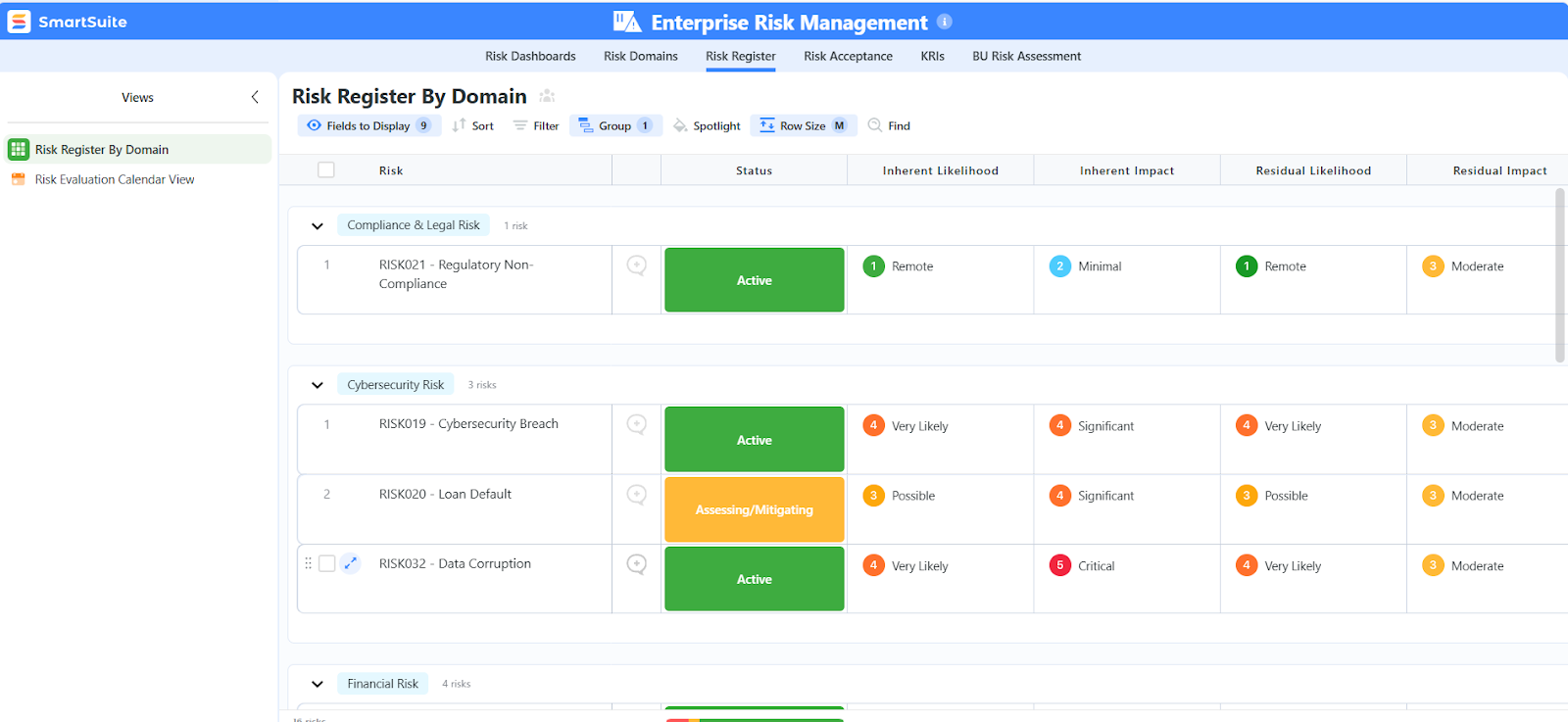
- Cross-team collaboration: Compliance, audit, and operations teams work together in a shared workspace with real-time updates, comments, and task ownership to eliminate silos.
- Integrated workflows: Link related processes, like policy reviews, incident response, and vendor assessments, so actions in one area automatically update the others.

- Automation-ready foundation: SmartSuite’s drag-and-drop workflow builder lets you automate approvals, reminders, and escalations across your entire GRC framework.
- Enterprise-grade security and permissions: Role-based access control, audit logs, and encryption ensure sensitive governance data stays protected while remaining easily auditable.
In short, SmartSuite acts as a command center for GRC - a single, connected platform where teams can identify, monitor, and manage risk with full visibility and control.
2. Advanced reporting and analytics
SmartSuite’s reporting features give GRC teams full visibility into every corner of their compliance, audit, and risk environment, without the complexity of third-party BI tools.
You can create powerful, real-time reports in minutes to monitor controls, track incidents, or assess risk exposure across frameworks and departments.
Here’s how SmartSuite makes reporting smarter for governance, risk, and compliance:
- Built-in interactive dashboards: Visualize risk trends, open issues, and compliance metrics in real time through customizable dashboards that keep leadership informed without manual reporting.

- Multiple report views: Instantly switch between Grid, Card, Kanban, Timeline, Map, Calendar, or Dashboard views to visualize your risk register, control testing results, or incident logs from different perspectives.

- Dynamic report toolbar: Filter by severity, control owner, regulatory framework, or audit cycle, group risks by category, and highlight overdue actions, all without leaving the report.
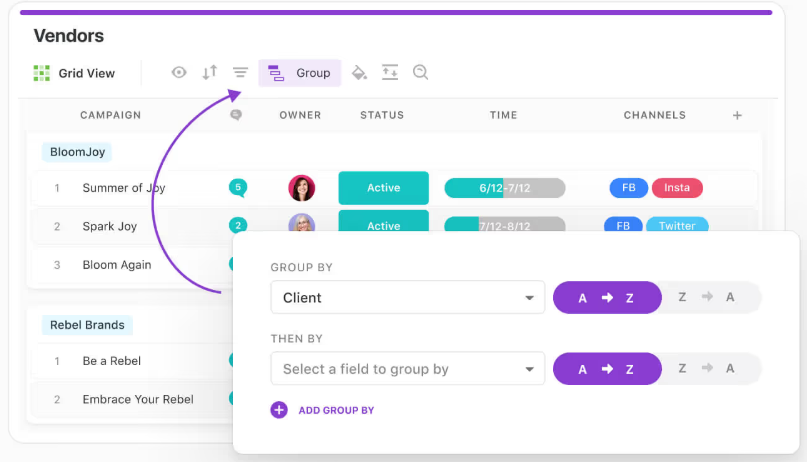
- Public and private reports: Create private working reports for internal review or publish shared dashboards that keep compliance and executive teams aligned in real time.
- Seamless export and sharing: Export any compliance or audit report to PDF, Excel, Google Sheets, or CSV, or schedule automated report delivery, so compliance updates, risk summaries, or audit dashboards land in the right inboxes on time.
- Mobile-ready insights: Access risk dashboards, audit results, and compliance KPIs anytime from web, tablet, or mobile, so decision-makers can stay informed wherever they are.
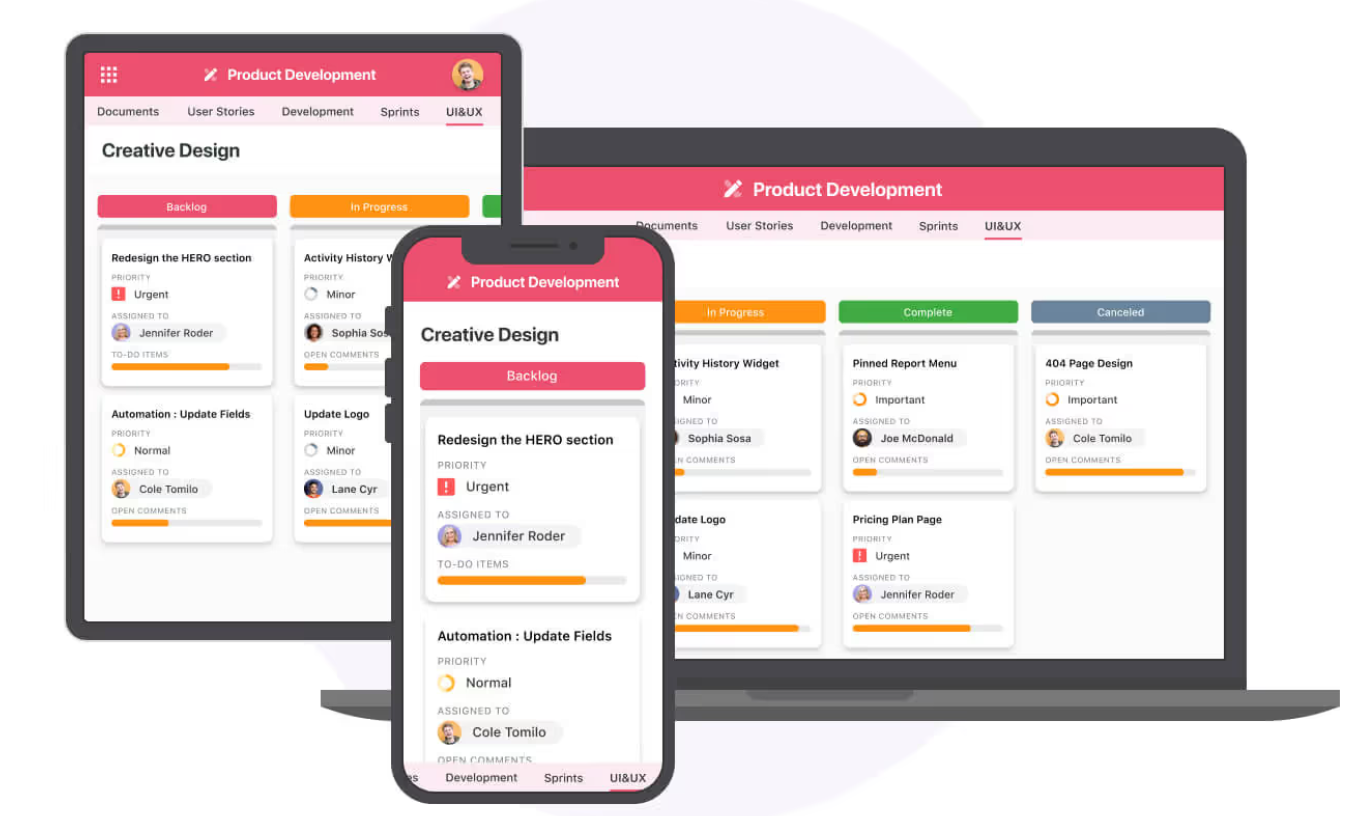
With SmartSuite, reporting isn’t just about documentation - it’s about proactive visibility.
3. Built-in automation and collaboration
SmartSuite’s real-time collaboration and automation features keep everyone aligned without manual chasing.
Automated notifications alert control owners when reviews or risk assessments are due, while workflow triggers route incidents, approvals, and corrective actions to the right people automatically.

Teams can also comment, tag colleagues, and share live dashboards, eliminating the endless back-and-forth of spreadsheets or static reports.
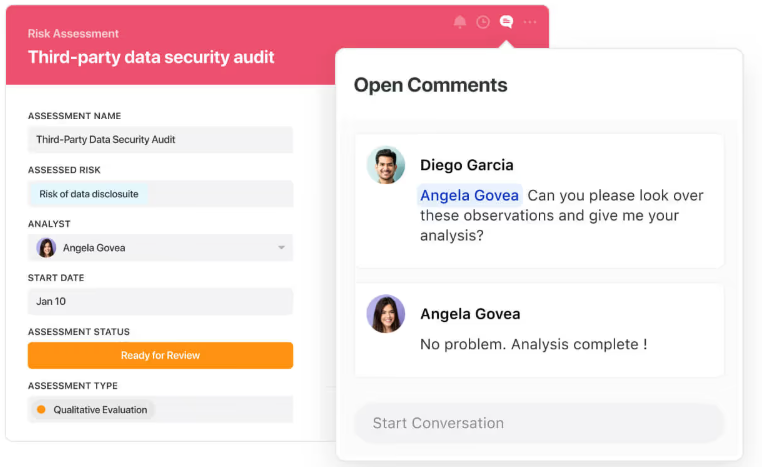
With everything happening in one shared workspace, compliance, audit, and operations teams can stay perfectly in sync.
In short, SmartSuite doesn’t just centralize GRC.
Instead, it connects people, processes, and insights right where the work happens, so your organization can act faster and stay compliant with less effort.
4. Ready-made, customizable templates
SmartSuite’s pre-built GRC templates give teams a quick start while providing them with the full flexibility to tailor workflows as they grow.
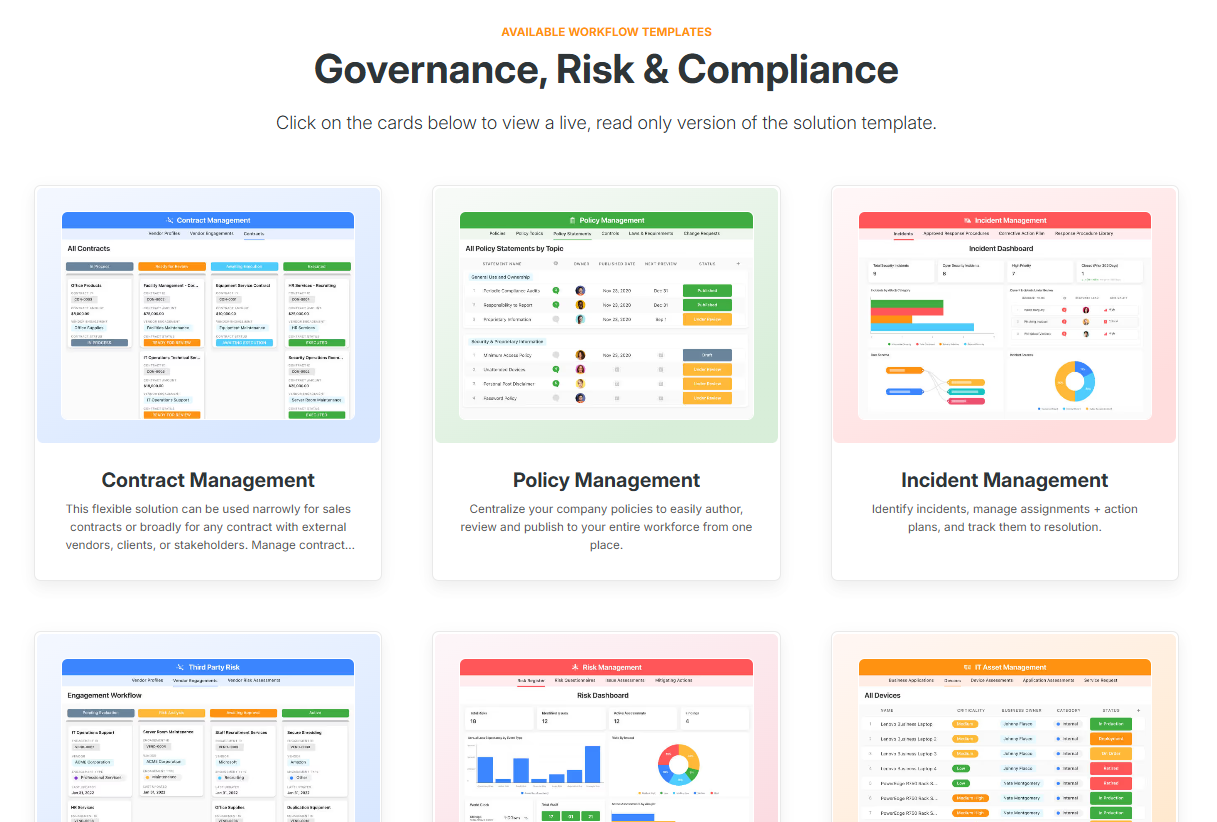
Each template is based on industry best practices and can be adjusted to reflect your organization’s exact risk appetite, reporting standards, and regulatory frameworks.
Popular templates include:
- Incident Management: Log, track, and resolve incidents with automated workflows, ownership assignments, and a full audit trail for regulators.
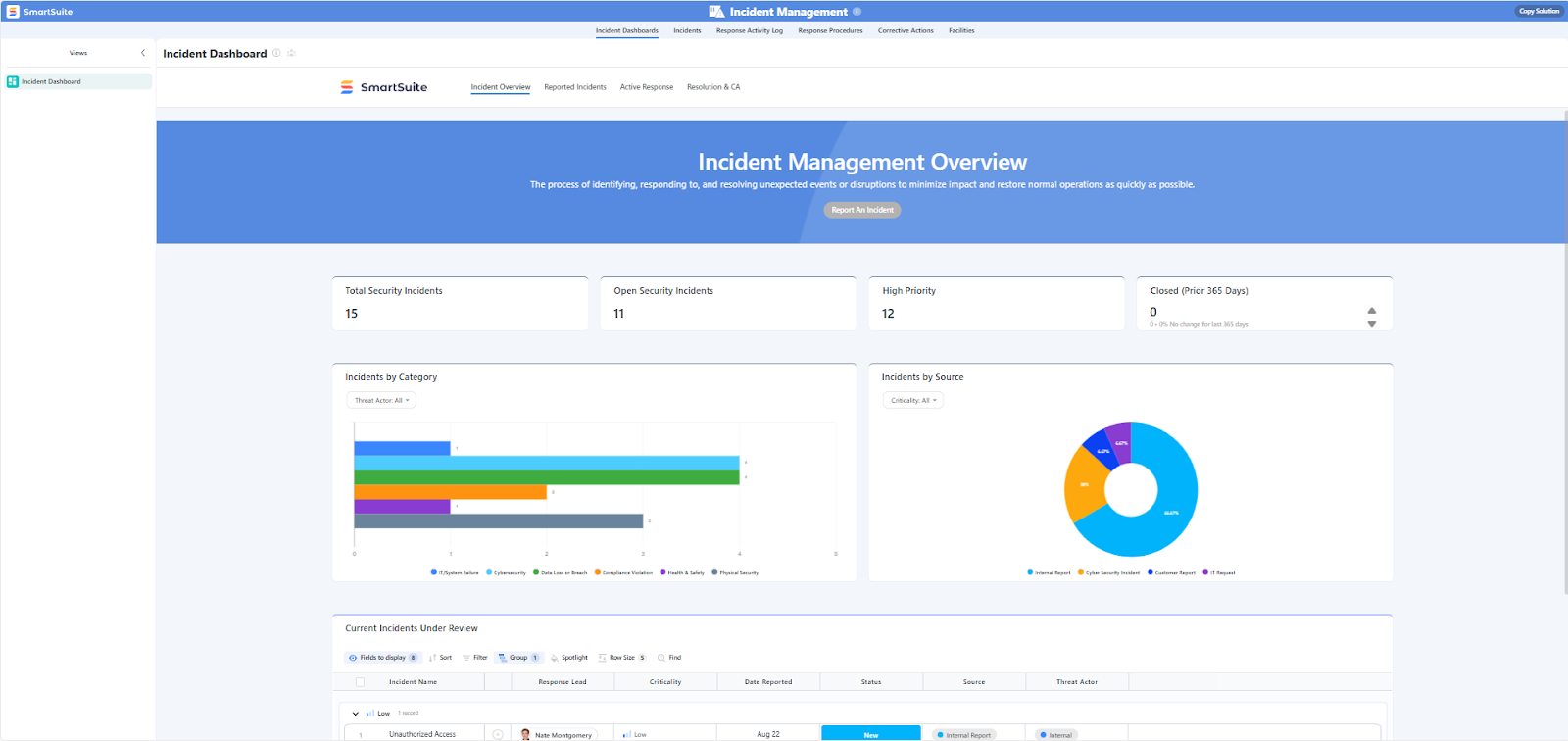
- Third-Party & Vendor Risk: Consolidate supplier data, automate due diligence reviews, and monitor ongoing compliance with built-in risk scoring.
- Privacy Management: Simplify GDPR, CCPA, and similar privacy compliance frameworks with pre-built templates and automated reporting.
- Business Continuity & Disaster Recovery: Design, test, and execute continuity and recovery plans to ensure operational resilience when disruptions occur.
- Regulatory Change Management: Track regulatory updates, assess their impact, and document how your organization adapts to maintain compliance.
- Audit Planning & RCSA: Plan and monitor audits, assign testing responsibilities, and automate risk control self-assessments (RCSA) to improve accountability.
Every template is interactive, so you can explore and test them directly to see how they fit before full rollout.
How does SmartSuite’s pricing compare to Protecht’s?
Where Protecht’s enterprise-style pricing can leave teams guessing until late in the sales process, SmartSuite stands out for its open, no-surprises structure, so you always know exactly what you’re paying for as your compliance needs grow.
The platform offers a Free Forever plan designed for individuals and small teams, giving access to core GRC templates, dashboards, real-time collaboration, and reporting features.
It supports up to 3 users, 5 solutions, and 1,000 records per solution, making it ideal for smaller teams or those piloting SmartSuite’s GRC capabilities before a full rollout.
And if you need more power, SmartSuite’s four paid tiers scale seamlessly with your organization’s growth and compliance maturity:
- Team: $12/user/month, includes everything in Free, plus unlimited solutions, 5,000 records per solution, 50GB of file storage, advanced collaboration tools, and a 30-day recycle bin.
- Professional: $30/user/month, includes everything in Team and adds advanced permissions, two-factor authentication, Gmail & Outlook integrations, AI features, and 100GB of file storage.
- Enterprise: $45/user/month, includes everything in Professional, plus audit logs, data loss prevention, up to 50,000 monthly API calls, and 500GB of file storage.
- Signature: Custom pricing, a fully tailored plan with no predefined limits, offering extended storage, API capacity, records, automations, and advanced enterprise security options such as SCIM provisioning and regional data residency.
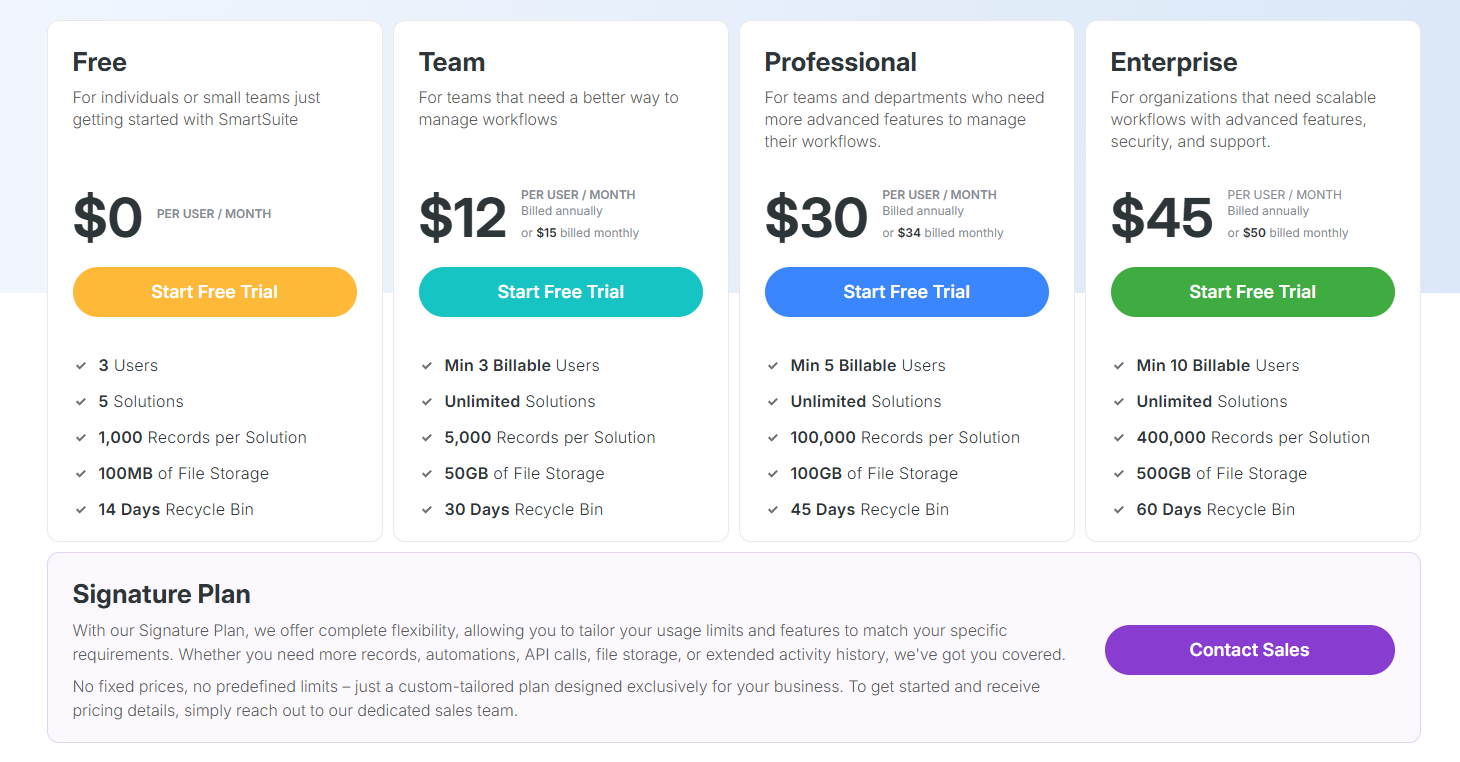
You can try any of SmartSuite’s first three paid plans with a 14-day free trial, giving your team hands-on access to every feature - no credit card needed.
How is SmartSuite different from Protecht?
SmartSuite and Protecht share the same goal - helping teams manage GRC effectively - but they take completely different paths to get there.
Here’s how the two platforms stack up:
- Pricing transparency: Protecht uses a custom-quote model, with pricing that varies based on users, modules, and configuration scope. SmartSuite, on the other hand, keeps things clear and predictable, publishing all plan details upfront, starting at $12 per user per month with a Free Forever plan and a 14-day free trial on all paid tiers.
- Ease of use: Protecht offers deep configurability but often comes with a steeper learning curve, as many reviewers note that its interface can feel dated or overly complex for non-technical users. SmartSuite is designed for simplicity from day one, with a modern UI, drag-and-drop customization, and zero coding required, making it accessible to both first-time GRC users and seasoned practitioners.
- Implementation and flexibility: Deploying Protecht typically involves longer setup cycles and formal onboarding due to its enterprise focus. SmartSuite flips that experience: teams can start instantly with ready-made templates, pre-built automations, and no outside consultants needed.
- Reporting and visibility: Protecht’s dashboards are customizable but can require additional setup or licenses for advanced analytics and lack depth and granularity. SmartSuite includes powerful reporting tools out of the box, from Grid and Kanban views to live dashboards and automated report delivery, so teams can track compliance, audit, and custom risk metrics in real time.
Simply put, Protecht remains a strong choice for complex, enterprise environments that need deep configurability.
On the other hand, for organizations seeking a faster, easier, and more transparent way to manage GRC, SmartSuite delivers the same power, without the heavy lift.
Final thoughts: Choosing the right GRC platform for your organization
Protecht remains a solid choice for organizations that need deep configurability and have the time and budget to manage a tailored, enterprise-scale deployment.
It’s built for large teams that value structure and control over flexibility and speed.
But for most modern businesses, the priorities have shifted.
In 2026, GRC teams want clarity, agility, and accessibility - tools they can set up quickly, adjust easily, and grow into without hidden costs or lengthy implementations.
That’s exactly where SmartSuite makes the difference.
It combines the sophistication of an enterprise GRC platform with the usability of a modern SaaS solution.
Everything from its ready-made templates and real-time dashboards to its drag-and-drop automation and transparent pricing is designed to help teams build, monitor, and scale their governance programs with confidence.
If you’re ready to modernize your GRC processes and eliminate the friction of complex systems, take SmartSuite for a spin:
Start your 14-day free trial today, no credit card required!
⚠️ Disclaimer: This article was last updated on 21/11/2025 and if there's any misinterpretation of the information, please contact us and we will fact check it.
Read more
- ZenGRC Pricing: Is It Worth It In 2026? [Reviewed] - Find out what ZenGRC really costs in 2026, what’s included in each plan, and whether its features justify the investment for your compliance program.
- 10 Best SAP GRC Alternatives & Competitors In 2026 - Explore the top SAP GRC alternatives that deliver enterprise-grade risk and compliance capabilities without the enterprise-level complexity or cost.
- Corporater Pricing: Is It Worth It For GRC In 2026? - See how Corporater’s custom pricing compares to modern, no-code GRC platforms that offer faster deployment and greater transparency.
- 10 Best Third-Party Risk Management Software In 2026 - Discover this year’s leading tools for assessing, monitoring, and mitigating vendor and third-party risks with automation and real-time visibility.
- IBM OpenPages Pricing: Is It Worth It In 2026? - Uncover the real cost of IBM OpenPages in 2026, what drives its pricing, and how it stacks up against more agile GRC alternatives.
- 10 Best Vendor Management Software & Tools In 2026 - Find the best vendor management platforms to streamline supplier onboarding, compliance tracking, and performance monitoring in one place.

Run your entire business on a single platform and stop paying for dozens of apps
- Manage Your Workflows on a Single Platform
- Empower Team Collaboration
- Trusted by 5,000+ Businesses Worldwide















